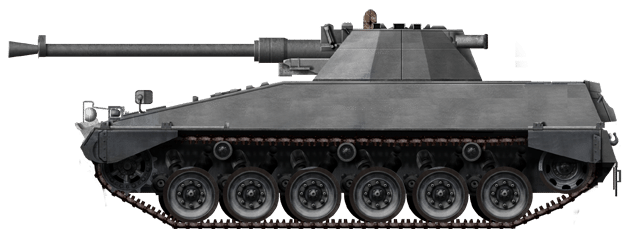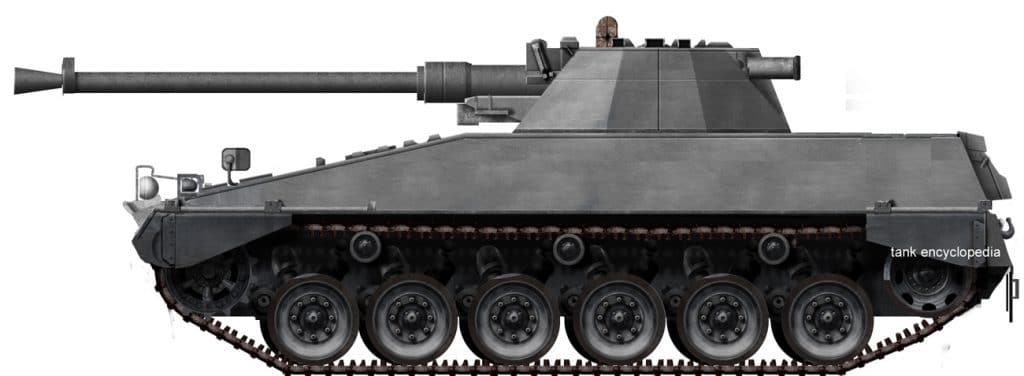 Federal Republic of Germany (1977)
Federal Republic of Germany (1977)
Infantry Fighting Vehicle – 1 Built
Believing they had identified a niche in the market, the Thyssen-Henschel and Bofors companies began a private venture (without funding or official support from the West-German military) to develop an ‘Infantry Escort Vehicle’.
The resulting vehicle, debuted in November 1977, was based on a modified hull of the recently introduced Marder IFV (Infantry Fighting Vehicle). It was designated the Begleitpanzer (Accompanying Tank) 57 and was classified as an Armored Infantry Fire Support Vehicle, or ‘AIFSV’.

The Marder
The Marder (German word for the weasel-like creature, the Marten) IFV entered service with the West German army or ‘Bundeswehr’ in 1971. It was developed as part of the rebuilding effort of Germany’s armored vehicle manufacturing industry. Though it was not a remarkable vehicle according to its features, the design has succeeded in being a versatile and well rounded IFV. It was a simple vehicle that had armor up to 20mm thick over the frontal arc, with the frontal upper plate steeply angled. This frontal plate was designed to withstand 20mm Armor-Piercing Discarding Sabot (APDS) rounds. It had rear access doors for carried infantry to disembark from and rifle ports in the hull side which allowed the infantry to fire through, while safely inside.
It had a small two-man turret which carried the IFV’s main armament, a 20mm Rheinmetall MK 20 Rh202 autocannon and a coaxial 7.62 mm MG3 machine gun. The 20mm can fire either Armor-Piercing (AP) or High-Explosive (HE) round.
The IFV was powered by an MTU MB 833 Ea-500 diesel engine, which developed 591 hp. This propelled the vehicle to a top speed of 47 mph (75 km/h) on road. It runs on six road-wheels connected to a torsion bar suspension. The idler wheel is located at the rear, with the drive sprocket at the front.

Design of the Begleitpanzer
The overall design of the vehicle was largely unchanged from the original Marder IFV. As such, the engine, transmission, suspension, tracks, and armor remained the same. The biggest modification to the Marder chassis was the replacement of the standard turret with a larger one mounting the vehicle’s main armament which consisted of an automatically cycling Bofors 57mm (2.24in) L70 Mk.1 gun, traditionally used in the anti-aircraft role on ships. This necessitated internal modifications. The entirety of the gun was open to the elements. When the gun was depressed the breach would rise out of the turret when elevated it would sink inside the hull. Depression/elevation range was – 8 to + 45 degrees. There was also a coaxial MG3 machine gun mounted on the right side of the main gun. The gun was fed from an ammunition can mounted on the gun cradle, meaning it would have to be reloaded from outside the tank. This gun was intended to engage with lightly armored enemy vehicles and troops.

The weapon was mounted centrally in the uneven turret. The left of the turret was raised to accommodate the commander’s position. Above this position was a periscope ring for all-round observation. The right half of the turret was much lower to accommodate the vehicle’s secondary armament, a Tube-launched, Optically-tracked, Wire-guided (TOW) Anti-Tank Guided Missile (ATGM) launcher, which could fire the BGM-71B missile. This was installed to give the vehicle some anti-armor capability. After firing, the launcher tube rotated backward until it was vertical, and the exhaust end was in line with the turret roof. A small circular hatch would then open. Through this, a fresh ATGM would be loaded in. The tube would then rotate back to firing position. The gunner was located underneath the ATGM launcher tube. He operated both the main gun and the ATGM with controls in his position.
Two loaders were positioned in the rear of the tank. The loader on the left would be responsible for loading clips into the 57mm main gun. The loader on the right would be responsible for handling the ATGMs. The ammunition load-out consisted of 48 rounds for the 57mm gun and 6 TOW-ATGMs. The driver was located at the front left of the vehicle.
Fate
A mock-up of the Begleitpanzer was displayed in November 1977. A prototype was tested in 1978. Due to a lack of interest from the German Military, the project was not accepted for construction.
The project did start a string of other attempts to increase the lethality of the Marder. A similar project by Thyssen-Henschel saw the addition of a 105mm L7 gun, as found on Leopard 1, to the top of the Marder chassis. This was designated the VTS1, but like the Begleitpanzer, it did not progress past prototype stages.

Illustration of the Begleitpanzer 57 by Tank Encyclopedia’s own David Bocquelet
Specifications |
|
| Dimensions (L-W-H) | 6.79 m x 3.24 m x 2.98 m (22′ 3″ x 10′ 8″ x 9′ 9″) |
| Total weight, battle ready | Aprx. 33.5 tons |
| Crew | 5 (driver, commander, gunner, x2 loaders) |
| Propulsion | MTU MB 833 Ea-500 diesel, 561 hp. |
| Suspension | Independent torsion bars |
| Speed (road) | 47 mph (75 km/h) |
| Armament | Bofors 57mm (2.24 in) L70 Mk.1 |
| Armor | 20mm (0.78 in) |
| Total Production | 1 Prototype |
Sources
Arms and Armour Press, Tanks of the World 1983, Ferdinand Von Senger.
On topwar.ru


6 replies on “Begleitpanzer 57”
Great to see article about Begleitpanzer 57, here. Love that vehicle. I look forward to see article about Marder 1 soon.
Have a nice day. 🙂
what about the idea on argentinian TAM?
Indeed, cheaper base. But i suppose it will pose some third-party licence problems on export
Nice idea anyway !
they already have a article on it.
The Begleitpanzer 57 is based on a TAM chassis, not a Marder one. The Marder’s chassis was too weak to support the weight and recoil of the 57mm, so they used the TAM’s chassis, which is reinforced. That also means the Begleitpanzer 57 had a supercharged 720hp engine, the MTU-MB 833 Ka-50, instead of the MTU-MB 833 Ea-500 of the normal Marder.
There seems to be a discussion werever it was a marder chassis or a TAM chassis. What gives? They never used any because it was only a design idea